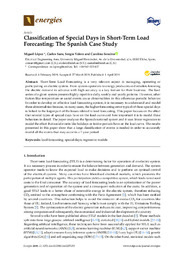Por favor, use este identificador para citar o enlazar este ítem:
https://hdl.handle.net/11000/34527Registro completo de metadatos
| Campo DC | Valor | Lengua/Idioma |
|---|---|---|
| dc.contributor.author | López García, Miguel | - |
| dc.contributor.author | VALERO, SERGIO | - |
| dc.contributor.author | Senabre, Carolina | - |
| dc.contributor.author | Sanz, Carlos | - |
| dc.contributor.other | Departamentos de la UMH::Ingeniería Mecánica y Energía | es_ES |
| dc.date.accessioned | 2025-01-15T19:46:02Z | - |
| dc.date.available | 2025-01-15T19:46:02Z | - |
| dc.date.created | 2019 | - |
| dc.identifier.citation | Energies | es_ES |
| dc.identifier.uri | https://hdl.handle.net/11000/34527 | - |
| dc.description.abstract | Short-Term Load Forecasting is a very relevant aspect in managing, operating or participating an electric system. From system operators to energy producers and retailers knowing the electric demand in advance with high accuracy is a key feature for their business. The load series of a given system presents highly repetitive daily, weekly and yearly patterns. However, other factors like temperature or social events cause abnormalities in this otherwise periodic behavior. In order to develop an effective load forecasting system, it is necessary to understand and model these abnormalities because, in many cases, the higher forecasting error typical of these special days is linked to the larger part of the losses related to load forecasting. This paper focuses on the effect that several types of special days have on the load curve and how important it is to model these behaviors in detail. The paper analyzes the Spanish national system and it uses linear regression to model the effect that social events like holidays or festive periods have on the load curve. The results presented in this paper show that a large classification of events is needed in order to accurately model all the events that may occur in a 7-year period. | es_ES |
| dc.format | application/pdf | es_ES |
| dc.format.extent | 31 | es_ES |
| dc.language.iso | eng | es_ES |
| dc.publisher | MDPI | es_ES |
| dc.relation.ispartofseries | 12 | es_ES |
| dc.relation.ispartofseries | 7 | es_ES |
| dc.rights | info:eu-repo/semantics/openAccess | es_ES |
| dc.rights | Attribution-NonCommercial-NoDerivatives 4.0 Internacional | * |
| dc.rights.uri | http://creativecommons.org/licenses/by-nc-nd/4.0/ | * |
| dc.subject | load forecasting | es_ES |
| dc.subject | special days | es_ES |
| dc.subject | regressive models | es_ES |
| dc.subject.other | CDU::6 - Ciencias aplicadas::62 - Ingeniería. Tecnología::621 - Ingeniería mecánica en general. Tecnología nuclear. Electrotecnia. Maquinaria | es_ES |
| dc.title | Classification of Special Days in Short-Term Load Forecasting: The Spanish Case Study | es_ES |
| dc.type | info:eu-repo/semantics/article | es_ES |
| dc.relation.publisherversion | https://doi.org/10.3390/en12071253 | es_ES |

Ver/Abrir:
energies-12-01253-v2.pdf
10,67 MB
Adobe PDF
Compartir:
 La licencia se describe como: Atribución-NonComercial-NoDerivada 4.0 Internacional.
La licencia se describe como: Atribución-NonComercial-NoDerivada 4.0 Internacional.
.png)